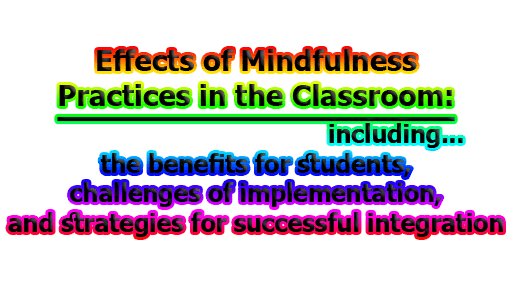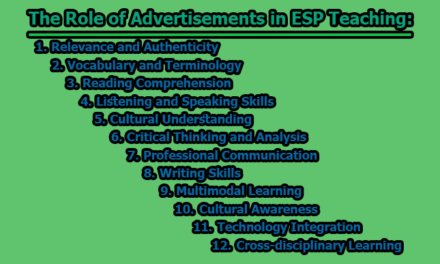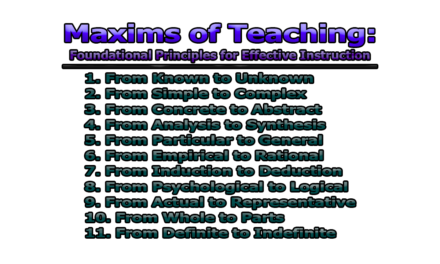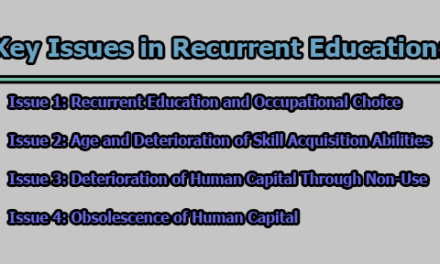Effects of Mindfulness Practices in the Classroom:
Mindfulness practices have become increasingly popular in recent years, both in personal and professional settings. The practice of mindfulness is a state of active, open attention to the present, with the goal of increased awareness and mental clarity. It involves being in the moment, observing thoughts and feelings without judgment, and focusing on the present rather than the past or future. Mindfulness practices have been shown to have numerous benefits for individuals, including reduced stress, improved emotional regulation, and enhanced well-being. In recent years, mindfulness practices have been introduced into classrooms as a means of promoting positive outcomes for students. This article will explore the effects of mindfulness practices in the classroom, including the benefits for students, challenges of implementation, and strategies for successful integration.
Benefits of Mindfulness Practices in the Classroom:
Mindfulness practices are becoming increasingly standard in schools as a means of promoting positive outcomes for students. These practices involve focusing one’s attention on the present moment, observing thoughts and feelings without judgment, and accepting the present situation. Mindfulness practices have been shown to have numerous benefits for students in the classroom, including:
a. Improved Attention and Focus: Mindfulness practices have been shown to improve attention and focus in students. By teaching students to focus on the present moment, they become more aware of their surroundings and are better able to focus on the task at hand. This can lead to improved academic performance, as students are better able to concentrate and retain information.
b. Reduced Stress and Anxiety: Mindfulness practices have been shown to reduce stress and anxiety in students. By teaching students to observe their thoughts and feelings without judgment, they are better able to manage their emotions and cope with stressors in a healthy way. This can lead to improved mental health outcomes and reduced absenteeism.
c. Improved Social-Emotional Skills: Mindfulness practices can also improve social-emotional skills in students. By teaching students to be more aware of their emotions and the emotions of others, they are better able to regulate their own behavior and empathize with others. This can lead to improved social relationships and a more positive classroom climate.
d. Improved Self-Regulation: Mindfulness practices can also improve self-regulation in students. By teaching students to be more aware of their thoughts and feelings, they are better able to manage their behavior and make better decisions. This can lead to improved academic and behavioral outcomes.
e. Improved Well-Being: Finally, mindfulness practices can improve overall well-being in students. By teaching students to focus on the present moment and appreciate what they have, they are better able to find joy and fulfillment in their daily lives. This can lead to improved motivation, engagement, and resilience in the face of challenges.
Challenges of Implementing Mindfulness Practices in the Classroom:
While there are several benefits to mindfulness practices in the classroom, there are also challenges to implementation. Some of the challenges include:
- Lack of Time: Teachers may feel that they do not have enough time in their busy schedules to implement mindfulness practices.
- Lack of Training: Teachers may not feel comfortable implementing mindfulness practices without adequate training.
- Resistance from Students: Students may initially resist mindfulness practices, viewing them as boring or irrelevant.
- Cultural Differences: Mindfulness practices may not be appropriate or relevant for all students, particularly those from different cultural backgrounds.
- Lack of Resources: Some schools may not have the resources to provide the necessary materials or training for mindfulness practices.
Strategies for Successful Implementation of Mindfulness Practices:
Despite these challenges, there are strategies that can be employed to successfully implement mindfulness practices in the classroom. These include:
- Start Small: Teachers should start with simple mindfulness practices that can be easily integrated into their daily routines, such as deep breathing exercises or body scans.
- Provide Adequate Training: Teachers should receive adequate training in mindfulness practices to feel comfortable and confident in implementing them.
- Engage Students: Teachers should engage students in the process of implementing mindfulness practices, soliciting their input and feedback.
- Tailor Practices to Students: Teachers should tailor mindfulness practices to the needs and interests of their students, taking into account cultural differences and individual preferences.
- Use Resources: Teachers should use available resources, such as books, online courses, or professional development opportunities to learn more about mindfulness practices and how to implement them effectively.
- Integrate Mindfulness into Curriculum: Teachers can integrate mindfulness practices into the existing curriculum, such as using mindful breathing exercises before a test or incorporating mindfulness into writing prompts.
- Build Consistency: Consistency is key in implementing mindfulness practices. Teachers should aim to incorporate mindfulness practices into their daily routines and create a predictable schedule for their students.
- Create a Positive Classroom Climate: Creating a positive classroom climate can help students feel comfortable and engaged in mindfulness practices. Teachers can foster a positive classroom climate by building relationships with their students, creating a safe and supportive environment, and modeling mindfulness practices themselves.
In conclusion, mindfulness practices can have various benefits for students in the classroom, including improved attention and focus, reduced stress and anxiety, improved social-emotional skills, improved self-regulation, and improved well-being. While there are challenges to implementation, there are strategies that can be employed to successfully integrate mindfulness practices into the classroom. By starting small, providing adequate training, engaging students, tailoring practices to individual needs, using available resources, integrating mindfulness into the curriculum, building consistency, and creating a positive classroom climate, teachers can successfully implement mindfulness practices and promote positive outcomes for their students.
References:
- Burke, C.A. (2010). Mindfulness-based approaches with children and adolescents: A preliminary review of current research in an emergent field. Journal of Child and Family Studies, 19(2), 133-144.
- Flook, L., Smalley, S. L., Kitil, M. J., Galla, B. M., Kaiser-Greenland, S., Locke, J., … & Kasari, C. (2010). Effects of mindful awareness practices on executive functions in elementary school children. Journal of Applied School Psychology, 26(1), 70-95.
- Kemeny, M. E., Foltz, C., Cavanagh, J. F., Cullen, M., Giese-Davis, J., Jennings, P., … & Wallace, B. A. (2012). Contemplative/emotional training reduces negative emotional behavior and promotes prosocial responses. Emotion, 12(2), 338-350.
- Mendelson, T., Greenberg, M. T., Dariotis, J. K., Gould, L. F., Rhoades, B. L., & Leaf, P. J. (2010). Feasibility and preliminary outcomes of a school-based mindfulness intervention for urban youth. Journal of Abnormal Child Psychology, 38(7), 985-994.
- Schonert-Reichl, K. A., & Lawlor, M. S. (2010). The effects of a mindfulness-based education program on pre-and early adolescents’ well-being and social and emotional competence. Mindfulness, 1(3), 137-151.
- Semple, R. J., Lee, J., Rosa, D., & Miller, L. F. (2010). A randomized trial of mindfulness-based cognitive therapy for children: Promoting mindful attention to enhance social-emotional resiliency in children. Journal of Child and Family Studies, 19(2), 218-229.
- Zenner, C., Herrnleben-Kurz, S., & Walach, H. (2014). Mindfulness-based interventions in schools—a systematic review and meta-analysis. Frontiers in Psychology, 5, 603.

Assistant Teacher at Zinzira Pir Mohammad Pilot School and College










